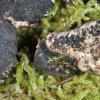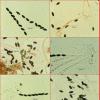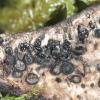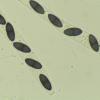
09-02-2008 16:11
Bonjour, Je vous dérange encore avec un asco su

09-02-2008 07:54
Bonjour, J'ai remis la main sur une Gibberella.

08-02-2008 11:10
Michel RIMBAUDHauteur 0,5mm. Entouré de poils noirs 3,4x200µ �

08-02-2008 11:05
Michel RIMBAUDHauteur 0,5mm. Entouré de poils noirs 3,4x200µ �

05-02-2008 22:53
 Yannick Mourgues
Yannick Mourgues
Bonsoir. Je cherche des données micro de Coleo

05-02-2008 22:07
Hello forum, last weekend we found a difficult op

05-02-2008 00:21
 Yannick Mourgues
Yannick Mourgues
Bonsoir. J'ouvre un nouveau sujet pour pas alou
Very interesting fungus !
Is it sure it comes on mosses. Could it grow on wood under mosses ?
Did you test Melzer reaction? I think it should be J+.
Apparently your cut is horizontal. Perhaps a vertical cut would be better to see and understand how is your fungus. Perhaps a Xylariaceae...
Alain
PS : you should change the title of this discussion ; for example : "Xylariaceae on mosses ?" bcause some ones among us won't look at discussion if the subject is "Pyronemataceae".

The spores are two-celled and the perithecia polystichous, which makes this fungus unlikely a Xylariaceae. Like Alain I wonder if the apical apparatus is going to react with iodine.
Such stromata with polystichous perithecia can be encountered in Boliniaceae. Can you make out a pore at any end of the spores? Observation in KOH may help to see a pore when it is inconspicuous.
Thanks for coming back with more details.
Cheers,
Jacques

I found this this article where Vasylyeva changed Bolinia lutea to Camaropella:
http://www.fungaldiversity.org/fdp/sfdp/25-13.pdf
Also a key to Camaropella is given, but no such big spores in that genus...
Apiocamarops has two-celled spores, but soft whitish stroma... it looks different:
http://www.cybertruffle.org.uk/cyberliber/59350/0080/005/0738.htm
Saludos,
Raúl
I just want to say that I loose a little my understandings in taxonomy with the first paper. For example, how is born the genus Camaropella ? I haven't the 1997-paper ot the author. Is there molecular study ? I need explanations.
Alain
Hello Alain, was going out on wood of Eryca, not on moss. The court is vertical (I enclose another photo). The reaction with Meltzer I have not tried, if I have tried with IKI and it is weak (I enclose photo). I have put Pyrenomataceae because I have no experience with this type of Ascos.

the apical apparatus seems indeed amyloid. This character combined with two-celled brown ascospores suggests affinities with Amphisphaeriaceae but I am not aware of any genus or species with such a stroma.
Can you send me a part of your collection, simply air dried for some days? Please do not mail it fresh in a plastic bag, it would arrive mouldy!
My address is
"Las Muros"
F 09420 Rimont
Cheers,
Jacques
Hello Jacques, I will look with KOH to clarify something if it can.

Jacques
Saludos
Si ça peut faire ton bonheur, le voilà !
Amitiés, Guy
Toujours aussi sympa et documenté !
Merci,
Alain

the microscopic features do resemble those of Amphisphaeria but no species with such a stroma is known occur in this genus.
Hope examination of your collection will help.
Jacques
Un saludo
I have sent to you a sample on Thursday 14.
A greeting

first sorry for having mistaken your first name with your surname!
Upon careful examination of your specimen, the apical apparatus of asci does not react with iodine, neither in Lugol nor Melzer (photo 2). It just turns faintly greenish yellow, which may be amplified by taking or processing the photo, as it probably occurred in the photos you attached.
Moreover an unconspicuous pore can be seen at either the proximal or distal end, more easily on immature less pigmented spores (black arrows).
All microscopic characters fit quite well the genus Pseudovalsaria Spooner, currently placed in Boiliniaceae, but the superficial turbinate stromata of your collection are very different from the small immersed stromata encountered in the type species P. ferruginea and P. peckii.
Further studies are still needed but it might well be a new species in that genus.
Anyway a very nice find!
Feliz Navidad!
Jacques
No tengo ninguna experiencia con el género Pseudovalsaria, si quieres algún dato más sobre nuestra recolección no tienes más que pedirmelo.
Un saludo y Feliz Navidad a todos, Plácido
Hello Jacques, the photos of micro are not retouched, it gives me the impression in my photos that if they react to the Iodo: perhaps do not yours react for being dry?
I do not have any experience with the genre Pseudovalsaria, if you want any fact more on our compilation you have only to ask me for it.
A greeting and Happy Christmas to all, Placido

I agree this is a bit troublesome. I can just suggest some possible explanations, most often the illumination of the microscope (too yellow) and/or the achromatic objectives account for artifacts in colours observed through the microscope.
The white balance settings of the digital camera may be also involved. I never observed variations in iodine reaction depending on fresh or dry state.
To see what a genuine blue amyloid reaction is, you should try with a specimen of Hypoxylon or Xylaria.
Cheers,
Jacques








